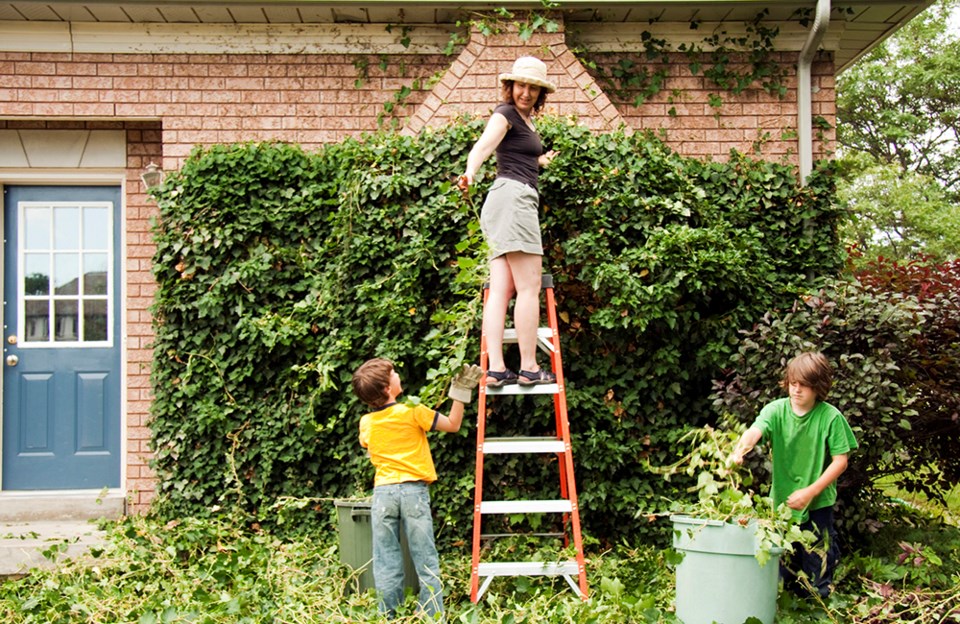There may be some playful irony that ivy leagues hold an air of prestige while the plant itself is often pesky, if pretty.
Whether a species is considered a plant, weed or an invasive is a topic gardeners, foresters and herbalists could wax on until the sun goes down. On the most basic level, invasives tend to be species that have been introduced into an ecosystem where they then thrive being great at reproducing and have no predators or pathogens to keep them in check.
English ivy has earned its placement on many municipalities’ lists of invasive plants because of its ability to grow quickly, creating a mat of vegetation that shades out other plants along the ground. Trees are also vulnerable.
A small amount of ivy growing on an evergreen doesn’t interfere with the tree’s health, however, a little ivy usually becomes a lot, given time. Once ivy has smothered a tree, the not-so-fun times begin as needed water and nutrients from the surrounding soil are robbed and resources available to the tree flag. Left unchecked, ivy has also been known to damage infrastructure with its robust trunk and sticky tendrils.
The illegal dumping of seemingly innocent house and yard plants in the backcountry is largely responsible for the spread of ivy. Free seasonal drop-off events for invasive plants are offered in most regions, including qathet’s spring event.
For the convenience of residents, year-round free disposal is also offered in other regions. Until such a service is offered, managing the spread of invasives requires a bit more planning. Additional guidance for this is available on the qathet regional district website.
To rebalance introduced species, people often volunteer their mental and physical muscles. Local ivy-pull groups have cropped up in the Powell River neighbourhoods of Townsite, Cranberry and Wildwood. Much like the vine itself, word of these group efforts is travelling quickly and there is talk of a new group forming in Westview to tackle Millennium Park’s waterfall of ivy.
To team up with the ivy-pull crew in Cranberry, contact Kate Sutherland ([email protected]) or simply show up for one of their monthly Valentine Mountain events. The next one takes place from 3 to 4:30 pm on September 24, meeting at the main parking lot at the end of Crown Street.
Volunteers of all ages are welcomed and rain doesn’t deter the hardy. Bringing garden gloves, clippers, loppers and garden saws, as well as wearing closed-toed footwear, are all recommended, but not necessary for participation.
Kate can also connect those interested with the co-ordinator for the Townsite group. Bill Bird ([email protected]) is the contact for the Wildwood pulls, which start up again in October.
Being inherently hard to kill, managing ivy requires removing pieces of its trunk. All ivy above that point then dies and flowering and seed production end along with them. Ivy along the ground is pulled and, rather surprisingly, balled up and wedged into the crook of a tree branch, where it dries out and re-rooting into the soil is prevented.
As with all ventures into the woods, exercising caution is a good idea. When pulling vines from trees, it is prudent to avoid working under compromised branches, which could accidentally fall onto do-gooders.
Despite its obvious annoyances, ivy is considered a resource to some who think outside the notorious invasive label. Creative thinkers have woven fully dried-out vines into robust mats that are then used on flood-prone hillsides to prevent soil erosion.
Artists with patience for finer work weave ivy baskets with dried and then re-soaked vine, and medicine makers have transformed the plant into treatments for arthritis, rheumatism and sunburn.
Contributing to the health of your local ecology weaves you into its fabric in a meaningful way, transforming you into a guardian rather than a mere consumer of its treasures. Whether it be an ivy pull, properly managing the invasives in your backyard, or sharing what you know about how invasives spread, you are becoming part of the solution rather than the problem.
Let’s Talk Trash is contracted by qathet Regional District to offer its waste reduction education program. For more information, email [email protected] or go to LetsTalkTrash.ca.



